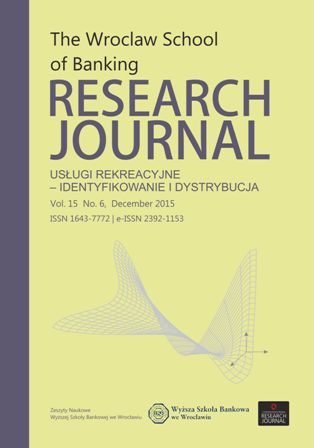HYBRYDOWOŚĆ, UŻYTECZNOŚĆ I ATRAKCYJNOŚĆ JAKO ATRYBUTY USŁUG REKREACYJNYCH (WELLNESS – FITNESS – SPORT DLA WSZYSTKICH)
DOI:
https://doi.org/10.29015/cerem.236Słowa kluczowe:
usługi, sport, rekreacja, hybrydowość, atrybuty usług, użyteczność, wizerunekAbstrakt
We współczesnym świecie potrzeba posiadania atrakcyjnego wyglądu, utrzymywania zadawalającego stanu zdrowia, sprawności życiowej i dobrego samopoczucia coraz silniej utrwala się zarówno w świadomości indywidualnej, jak i wspólnej. Zwiększa się więc zapotrzebowanie na usługi rekreacyjne, obejmujące wellness, fitness, jak i te określane jako sport dla wszystkich. Usługi te możemy postrzegać jako produkt komercyjny, będący odpowiedzią na potrzeby klienta korporacyjnego oraz klientów indywidualnych. Usługa rekreacyjna jest kategorią dynamiczną, mniej lub bardziej złożoną, a jej atrybuty wyznaczane są hybrydowością usług, przejawianych zarówno w użyteczności, jak i atrakcyjności, które z kolei wyznaczają poziom korzyści i wartości dla klienta. Biorąc pod uwagę powyższe założenia, wyznaczono wzajemnie zależne cele publikacji, w tym:
- dokonano analizy zakresu hybrydowości usług rekreacyjnych, uwzględniając ich pragmatyczny i sieciowy wymiar,
- zidentyfikowano główne wyznaczniki hybrydowości usług rekreacyjnych, tj. ich praktyczną użyteczność i wizerunkową atrakcyjność,
Bibliografia
Brożek Z., Kwilecka M. (2006), Bezpośrednie funkcje rekreacji, Warszawa, WSE.
Dąbrowski A. (2006), Zarys teorii rekreacji ruchowej, Warszawa, WSE, s. 11.
Dyraga B. (2003), Czym jest fitness dla wellnessu?, „Body Life” nr 3.
Grodzka-Kubiak E. (2002), Aerobik czy fitness. Poznań.
Kotler P. (1996), Marketing: analiza planowanie, wdrażanie i kontrola, Warszawa, Geberthner i Spółka.
Marciszewska B. (1999), Konsumpcja usług rekreacyjno-sportowych, AWF Gdańsk.
Mc Kenna R. (1993), Relationship Marketing. Successful Strategies for the Age of Customer, NY, Addison-Weseley Publishing Comp.
Mickiewicz A. (2000), Jaki Fitness, „Body Life” nr 1.
Panfil R. (2008a), Podstawy zarządzania turystyką i rekreacją, Leszno, Państwowa Wyższa Szkoła Zawodowa.
Panfil R. (2008b), Synergiczne postrzeganie zespołowości – kaprys poznawczy czy praktyczna konieczność, Leszno, Leszczyńskie Towarzystwo Przyjaciół Nauki.
Panfil R. (2012), Fitness jako produkt [w:] Produkty sportowe – identyfikacja, rozwój, dystrybucja, Wrocław, Wyższa Szkoła Zarządzania i Coachingu.
Payne A. (1996), Marketing usług, Warszawa, PWE.
Radomski M. (2002), WELLNESS – jak osiagnać ten stan?, „Body Life” nr 4.
Szymański I. (2000), Fitness-aerobik, „Body Life” nr 1.
Toczek-Werner S. (2005), Podstawy rekreacji i turystyki, Wrocław, AWF.
Pobrania
Numer
Dział
Licencja
Autor przenosi nieodpłatnie na Wyższą Szkołę Bankową we Wrocławiu , bez ograniczeń terytorialnych, majątkowe prawa autorskie do tego utworu w rozumieniu ustawy z dnia 4 lutego 1994 roku o prawie autorskim i prawach pokrewnych ( Dz.U. 1994, Nr 24, poz. 83 ze zm. )na zasadzie wyłączności, tj. prawo do:
a) wyłącznego używania i wykorzystania utworu w dowolnej działalności przez Wyższą Szkołę Bankową we Wrocławiu, w szczególności w działalność Biblioteki Cyfrowej uruchomionej przez Wyższą Szkołę Bankową we Wrocławiu
b) wytwarzania, utrwalania i zwielokrotniania egzemplarzy utworów wszelkimi technikami, w tym techniką drukarską, reprograficzną, zapisu magnetycznego oraz techniką cyfrową, w szczególności ich zwielokrotniania poprzez dokonywanie zapisów na płytach typu CD,
c) zamieszczenia wybranych fragmentów utworu w celach promocyjnych w publikacjach, materiałach promocyjnych, w sieci Internet oraz sieciach wewnętrznych typu Intranet Wyższej Szkoły Bankowej we Wrocławiu,
d) wprowadzania utworu do pamięci komputera Wyższej Szkoły Bankowej we Wrocławiu,
e) kopiowania i powielania utworu w technologiach fotomechanicznych lub innych znanych w dniu zawarcia umowy (fotokopie, kserokopie itp.),
f) przetworzenia dzieła na formę elektroniczną i nieograniczonego rozpowszechniania w sieci Internet.


